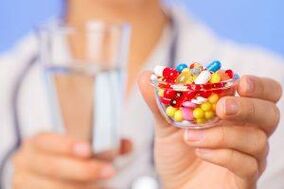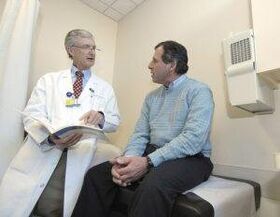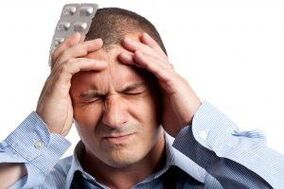
Prostatitis is a disease of the prostate that can be very painful, but with a proper comprehensive approach, the disease recedes. Let's take a closer look at the most famous method of medication -antibiotic use- What antibiotics should be taken for men with prostatitis and which are the best?
Antibiotics

Medication for prostatitis is usually limited to treating the symptoms. Painkillers can relieve pain. In men, antibiotics are used to treat prostatitisfor patients with acute or chronic infectionsprostate.
E. coli and other Gram-negative bacteria cause most acute prostate infections.Symptoms includegroin pain, dysuria, pain during ejaculation, inability to urinate, and fever, general malaise.
In men, the treatment of prostatitis is always an antibiotic. Chronic infectious prostatitis may require long-term drug treatment, and severe infections may require hospitalization where the drugs are administered parenterally.
The rest of this article will look at how to treat prostatitis in men with antibiotics.
Advantages and disadvantages
In case of infection or recurrence within one year, antibiotics are always recommended. For effective treatment, the following are recommended:
- Acute infectious prostatitis;
- Chronic infectious prostatitis.
The benefits of the drugs are:
- Strongbactericidal properties;
- Bacteriostatic propertieswhich prevent the growth of bacteria;
- High efficiency- covers a wide range of infections;
- Easy use. Most medications are taken orally or by injection;
- Few side effects;
- Economymedicines are widely available and inexpensive.
Disadvantages includesystemic side effects, which vary depending on the antibiotic selected and most commonly include:
- Diarrhea.During treatment, sugar in the intestines often rises, causing intestinal dysbacteriosis;
- Fungal infectionsoral cavity, genitals;
- Formationkidney stones;
- Coagulation disordersblood (when taking some cephalosporins);
- Photosensitivity(when taking tetracyclines);
- Blood disorders("dense" blood syndrome);
- Deafness(rarely).
Also common side effects:
- Possibilityallergic reaction;
- resistance of certain bacteria. This occurs when the patient is not taking the full dose.
Types of antibiotics

The patient is most often prescribed4 week course, but if your urologist suspects chronic prostatitis and the signs (as well as the pain) do not go away after four weeks of treatment, you may recommend a longer dose.
Sometimes courses of up to three months are used.
Antibiotics for the treatment of prostatitis in menprescribed by your doctordepending on:
- The pathogen that causes the infection;
- Forms of the disease (acute / chronic);
- Severity of symptoms;
- The general health of the patient;
- disease.
And based on the results of suchanalyzeshow to:
- Blood test - extended profile;
- general urine analysis;
- urethral PCR (smear);
- Container. Urine culture;
- Analysis of prostate secretion.
Types of antibioticsused in prostate therapy:
- macrolides;
- Penicillins;
- tetracyclines;
- Fluoroquinolones;
- Cephalosporins.
Which antibiotic is better and more effectivewith prostatitis? Consider the names of prostatitis antibiotics:
| Wording | Efficacy of the drug | Action taken | Suggestions for use (more details in the guide) |
|---|---|---|---|
| Macrolide medicine | It is effective against urinary tract diseases (inflammation of the prostate, urethritis, cervicitis, epididymitis). | Slows the active growth and multiplication of bacteria, has antiseptic and antimicrobial effects, bactericidal | 1-2 g 2-3 r / day Dosage form: 10 tablets. 500 mg |
| A semi-synthetic drug belonging to the macrolide group, a derivative of erythromycin | It is effective in the treatment of chronic infectious prostatitis | Broad-spectrum antibiotic. It has an extensive spectrum of antimicrobial activity, many bacteria that cause prostatitis (streptococcus, Klebsiella, Escherichia coli, staphylococcus aureus) | 0, 15 g 2 r / day before meals with plenty of fluids Available in 10 capsules. 0, 15, 0, 3, 0, 1 and 0, 05 g each |
| Tetracycline derivative | Effective for the treatment of infections such as acute / chronic inflammation of the prostate, chlamydia, gonorrhea, syphilis | It has bacteriostatic and anti-inflammatory effects | With plenty of fluids, 200 mg once a day and then 100 mg once a day In the form of capsules 10 pcs. 100 mg |
| A semi-synthetic drug belonging to the group of cephalosporins | Antibiotic for the treatment of acute bacterial prostatitis in men. It is used against the background of severe bacterial infections | It has an antimicrobial, bactericidal effect. Active against several microorganisms causing prostatitis (streptococcus, staphylococcus aureus) | Intramuscularly or intravenously, 1 g every 8-12 hours Formulation: In ampoules of 0, 5, 1 or 2 g |
| Cephalosporin preparation (as sodium salt) | It is used to treat severe bacterial infections (inflammation of the prostate, inflammation of the epididymis). | Antibacterial, bactericidal | Intramuscularly or intravenously, 1-2 g every 12 hours Available in 0, 5, 1 or 2 g bottles |
| Semi-synthetic, broad-spectrum penicillin group antibiotic and clavulanic acid | The antibiotic is used to treat inflammation of the prostate and to treat gynecological infections and respiratory infections. | It has a bactericidal effect on Gram-positive and Gram-negative aerobes / anaerobes | 1 tablet of 250 mg (+125 mg) every 8 hours Manufactured in tablets of 250 + 125 mg |
| It is a semi-synthetic drug belonging to the penicillin group | It is used to treat infections of the urogenital system (urethritis, prostatitis, pyelonephritis). | Antibacterial, bactericidal | Antibiotic for prostatitis, intramuscular or intravenous injection, 500 mg 3 r / day or tablets 500 mg every 8 hours It is available in ampoules of 500 mg or in tablets of 20. 500 mg |
| Lomefloxacin hydrochloride | It is used to treat inflammation of the prostate, chlamydia, pyelonephritis, urethritis | Antibacterial, bactericidal, active against gram-negative microorganisms causing prostatitis | Tablets inside 400 mg 1 r / day In the form of capsules 10 pcs. 400 mg |
| Fluorinated carboxyquinolone, a synthetic chemotherapeutic agent | The antibiotic is used to treat inflammation of the prostate | Against active bacteria such as streptococci, staphylococci, chlamydia | 250 mg oral tablets with or without food, with or without food In the form of tablets 5 pcs. 250 mg |
| An antibiotic belonging to the group of fluoroquinolones | Infections of the urinary tract, pelvic organs, genitals | Antibacterial, bactericidal, active against bacteria such as streptococcus, staphylococcus, chlamydia, enterococcus, mycoplasma | 1 tablet before meals 200-800 mg / day In the form of tablets 10 pcs. 200 mg |
| It belongs to a group of medicines called tetracyclines | It is used to treat respiratory infections, chlamydia, prostatitis, syphilis | Antibacterial, bacteriostatic effect | 1 tablet 250-500 mg 4 r / day In the form of tablets 10 pcs. 250 mg |
Only your doctor can decide which antibiotic complex is right for you.
If the antibiotic did not help with inflammation of the prostate, it may turnfolk remediesand try treating prostatitis without antibiotics. Here are some of them: pumpkin seeds and honey, propolis, propolis candles, dead bees, soda and hydrogen peroxide, and monastic tea, Ivan’s tea and onions. You can also buy a Chinese prostatitis patch.
Injections

If the body does not respond to oral treatment, parenteral administration (intravenously / intramuscularlyusually in the buttocks).
This method is also used to treat chronic / acute infectious prostatitis. This should only be considered after trying all other options, including oral antibiotic treatment for prostatitis, corticosteroid treatment, and conventional medicine.
Parenteral administration is used when a patient has taken several antibiotics for several months and each has been ineffective.
This reaction is due to the fact that infectious prostatitis is often caused by a local inflammatory process underlying an autoimmune disease, and oral medications do not produce the desired effect.
What injections are given for prostatitis?
Antibiotics are commonly used for intravenous (and intramuscular) administration.3rd generation cephalosporin groups.The injections are performed strictly in the hospital. After 5 injections, relief usually occurs.
Contraindications

Contraindications usually depend on the particular drug, but most often are:
- Gastrointestinal disorders(especially when taking macrolide medicines);
- allergic reactions (hives);
- Renal and hepatic impairment(usually in the background of taking penicillins, cephalosporins, macrolides);
- As a child(Caution until age 18);
- Diabetes.
How to take
The tablet should be taken with 1, 5-2 glasses of water, the medicine should be taken with food (unless otherwise instructed) so as not to irritate the stomach. Drink after antibiotic therapymedication to restore the intestinal flora.
Attention!Avoid alcohol completely during treatment.
Exchange
Infectious prostatitis has been successfully treated with antibiotics, but if it is contraindicated or has an individual intolerance, is hypersensitive to certain components of the drug, or if antibiotics do not help with prostatitis, so-callednatural antibioticswith prostatitis. They are most often less effective in combating the infectious form of the disease. So what can replace antibiotics in prostatitis?
Most usedechinacea, contains a special substance - echinacoside, whose properties are completely different from traditional antibiotics.
The plant is used to make infusions, herbal teas and decoctions that allow the relief of prostatitis without antibiotics.
It has a similar effectpoplar bark, called a "natural" antibiotic.
For the treatment of the bacterial form of the diseaseto be appointed:
- alpha-blockers;
- non-steroidal anti-inflammatory drugs;
- corticosteroids;
- 5-alpha inhibitors (slows prostate growth);
- Laxatives.
With timely medical care and a comprehensive approach to treatment, bacterial prostatitis can be completely cured with a single antibiotic treatment.



























